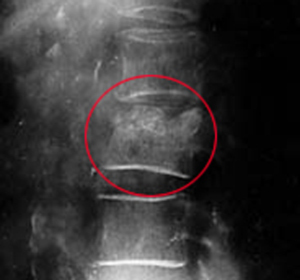
The lower part of the coat of arms of the English-language sources call the pain in the lower back (low back pain). The pain often contributes to the tension in the lumbar spine, limitation of motion, and antalgic scoliosis. Acute back pain can last from several days to several weeks.
Causes, incidence, and risk factors for low back pain
Pain in the back occurs in almost every man at least once in your life. It should be noted that pain can be in any part of the arms, but, nevertheless, pain in the lumbar spine appears most often. This is due to the fact that the lumbar vertebrae bear the maximum load from the weight of Your body.
The lower part of the coat of arms is on the second place by the number of visits to the physician immediately after a viral infections.
You may feel pain in the lower back after lifting heavy weights, sudden movements, after finding a long time in one position or after the spinal injury.
Sharp pain in the lumbar spine, most often caused by the displacement of the intervertebral disk and spinal cord injury.
The reasons for back pain:
- Osteochondrosis of the lumbar spine
- Intervertebral hernia and protrusion of intervertebral discs
- Spondiloarthrosis
- Spondylosis
- Spondylolisthesis
- Compression fracture due to osteoporosis, multiple myeloma, hemangioma of the spine
- A tumor in the lumen of the spinal canal
- Fractures of the spine after injury
- Prolonged muscle tension
- Anatomically narrow spinal canal
- Curvature of the spine (scoliosis, kyphosis, kyphoscoliosis, disease President UIA)
- Aortic aneurysm
- Rheumatoid arthritis, psoriatic arthritis, osteoarthritis
- Spinal infection - osteomyelitis, discitis, tuberculosis of the spine
- Pyelonephritis, urolithiasis
- Complicated during pregnancy
- Gynecological diseases (endometriosis, ovarian cyst, cancer of the ovaries, etc.)

The symptoms of low back pain (pain in the lower part of the back)
The pain can be different: sharp, dull, pulling , burning, may be accompanied with prickling and formication, numbness.
The intensity of back pain can vary from mild to unbearable pain that interferes to make the slightest movement. The pain can be combined with pain in the hip, pain in shins, pain in the leg.
Diagnosis of lower back
First, you need to consult a doctor-neurologist. The doctor will ask questions about the nature of your pain, its frequency of repetition. The doctor will try to determine the cause of the pain and begin the treatment of simple methods (ice, moderate pain relievers, physical therapy and necessary exercise).
In most cases, these treatments for pain in the back. During the examination the doctor will determine the exact location of the pain, its radiating, neurological reflexes. Most people with pain in the lumbar spine recover within 4-6 weeks.
Diagnosis include magnetic resonance imaging (deu. MRI) of the lumbar spine, computed tomography of the lumbar-sacral spine, x-rays of the spine.
Because the most common cause of back pain is Intervertebral hernia lumbar-sacral spine, the first thing You need to do an MRI of the lumbar spine. This study will also help to eliminate most causes of pain, such as tumor in the lumen of the spinal canal, tuberculosis of the spine, spinal fracture, multiple myeloma, anatomically narrow spinal canal, spondylolisthesis, different kind of curvature of the spine, spondylosis and spondylosis. If Your neurologist did not give the MFA, do it yourself. The power of the MRI machine should be 1 Tesla or more.

Don't start diagnosis with x-rays and computed tomography, these methods are unsafe. You can make them in the first place only in cases of suspected fracture of the spine.
Here are some tips on what to do when the pain in the back:
- Reduce physical activity for the first two days after the attack. This will help in reducing the symptoms of the disease and swelling in the area pain.
- Do not sit, bend forward until the pain has completely subsided.
- Take painkillers only in case of unbearable pain. It is better to make the intramuscular injection of the drinking of the anesthesia. This will protect the wall of Your stomach from direct contact with the anti-inflammatory agent. Try to avoid excessive intake of drugs. Not be used to treat hormonal, if low back pain is not associated with autoimmune diseases.
- Sleeping in a fetal position, place a pillow between your legs. If you usually sleep on your back, place a pillow under the knees
- A common misconception is the idea that you have to limit physical activity for a long time. Bed rest is not recommended!!! If you do not have fever, weight loss, involuntary urination and defecation, You need to stay active as much as you can stand it. You can reduce your activity only for the first two days after the onset of pain. To start doing light aerobic exercise. Walking on the treadmill, swimming can help to improve the flow of blood to the muscles of the back. Consult with your doctor for choice of exercises, so as not to cause amplification of the pain syndrome.
Forecast:
Most people feel much better after the first week of treatment. After 4-6 weeks, a significant percentage of patients the pain disappears completely.

In some cases you should immediately consult a doctor:
- Lower back pain in combination with pain in the lower leg and foot pain
- The pain will not allow You to service
- The pain is combined with urinary incontinence and fecal incontinence
- The combination of pain in the lower back with numbness in the buttock, thigh, leg, foot, groin
- If You have already had back pain before
- If the pain lasts more than 3 days
- If you are taking hormones
- If the pain appears after an injury
- Was previously diagnosed with cancer
- If You lost weight recently for unclear reasons





































